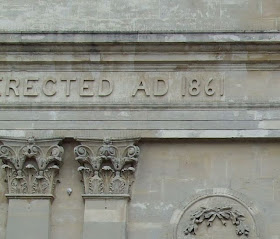Hub
"Corn exchange": a phrase that I remember puzzling me as a child. What did they do in there, swap wheat for barley? Exchange bad jokes and puns? At some point, someone put me right, and much later I came across Adrian Bell's book Corduroy, his account of leaving the literary and artistic world of London and learning to farm in Suffolk in the 1920s, with its description of farmers and merchants bargaining in the local corn exchange. A market for farmers, then (not a farmers' market), and the hub of many an English country town.
And in many of these towns, the corn exchange is still an imposing building in the centre or on the market place. This one is in the middle of Newbury and is built in Italianate style, with tall arched windows and big classical pilasters. The design was by J S Dodd and the building was put up in 1861–2; it has no doubt been impressing everyone from passers-by to rookie farmers ever since. The details are quite interesting – the name of the building in thin but pleasant lettering (in what lettering experts call, with no disrespect to the form, grotesque capitals) and a roundel with a relief of a castle, its three stylized towers a version of the castle on the Newbury coat of arms.
Now that farmers no longer need to gather together to haggle and sell their crops, corn exchanges need to find new uses to survive. Many have become the venues for other kinds of markets. This one is an arts centre. I'm not sure what Adrian Bell would have thought about this. Perhaps the Londoner, turned farmer, turned writer would have smiled wryly.
- -
If the name of Adrian Bell sounds familiar, it may be because of his charming books about farming and the English countryside. Corduroy is a good place to start: a gentle, beautifully observed story of the author's induction into farming life and of how he learns his profound respect for the hard work and deep knowledge of the farmer whose eye for a pig, he discovers, is "as subtle as an artist's". Its sequels are Silver Ley and The Cherry Tree. The name may also be familiar because at least two of Bell's children have made a useful mark in the world – they are the politician and journalist Martin Bell and the translator Anthea Bell (whose English versions of the Asterix books have amused generations and whose more literary translations, of books such as W G Sebald's transcendent Austerlitz, are superb).


I don't suppose you looked round the back? It used to be brick with iron fire escape and the back entrance for performers when it was a grand concert hall in the 40s and 50s, everything from visiting performers, Chamber of Commerce Annual Balls and local operatic societies (Gilbert & Sullivan)and dancing schools appearing.
ReplyDeleteAs for the Corn Exchange - I am always reminded by the scene in Hardy's Far from the Madding Crowd when Bathsheba goes to trade corn amongst all the farmers.
I usually try to go around the back of buildings, but missed the back of this one for some reason. I remember the scene from the Hardy novel, though - a woman going into a man's world, and lightening it up, as one of the farmers says.
ReplyDeletei've got Bell's 'Men and the fields' and very good it is too
ReplyDelete